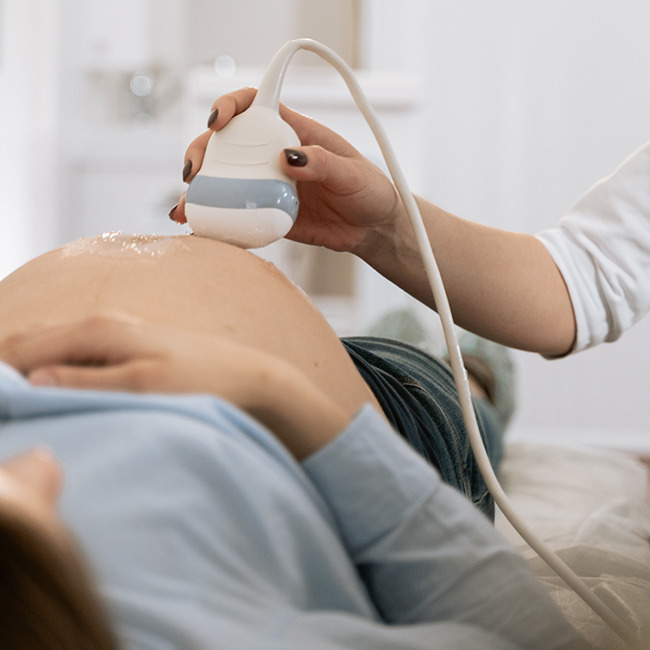Pregnancy monitoring

Are you expecting a happy event? We can help you with your analyses throughout your pregnancy.
Pregnancy is a special time in every woman’s life. Medical monitoring is essential to ensure that everything is going well for the mother-to-be and the fetus, and to detect any complications.
Gestational diabetes and the OGTT test
Gestational diabetes is an increase in blood sugar levels that appears during pregnancy and usually disappears after delivery.
Approximately 5% of pregnant women are affected by this condition.
What is gestational diabetes ?
Gestational diabetes is an increase in blood sugar levels that appears during pregnancy and usually disappears after delivery.
Screening for gestational diabetes is necessary for women at increased risk of developing the condition. It is carried out in the first trimester of pregnancy by a blood test to determine fasting blood glucose levels, and in the second trimester by an oral glucose tolerance test (OGTT).
This condition is asymptomatic, which means that it has no discernible effects on the pregnant woman, and the only way to detect its onset is through laboratory testing.
Perform an OGTT (hyperglycemia) test by appointment
The aim of the OGTT test is to monitor the reaction of the mother-to-be’s body to the ingestion of a high-sugar solution. The test is performed as follows: The test is performed in the laboratory after fasting for 10 to 12 hours.
Screenin involves 4 steps :
- An initial fasting blood test
- This is followed by the ingestion of a highly sweetened drink containing 75g of glucose
- A second blood test is taken 1 hour after ingestion of the glucose solution
- A third blood test is taken 2 hours aftr ingestion of the glucose solution
Screening is not very pleasant for pregnant women (very sweet drink).
IMPORTANT: The laboratory test takes 2 hours. Don’t forget to bring something to keep you busy!
Should I get tested ?
Screening is not systematic and should be performed in women most at risk:
- Diabectic close family member
- Personal history of gestational diabetes in a previous pregnancy
- Age (over 35)
- Overweight
Screening can also be suggested in the case of heavy babies (macrosomia).
When and how to get tested ?
- Fasting blood glucose: in the 1st trimester or before pregnancy.
- Oral glucose tolerance test (OGTT): during the 2nd trimester of pregnancy, between 24 and 28 weeks of amenorrhea.
What are the risks of gestational diabetes?
For the mother :
There is an increased risk of pre-eclampsia (high blood pressure in the mother associated with elevated protein levels in the urine) and the threat of premature delivery.
For the baby :
- The baby’s weight can be high at birth (macrosomia), which can have consequences during delivery for the child or the mother (Caesarean section).
- There is also a risk of hypoglycemia in newborns.
Important to know: in gestational diabetes, there are no malformations. The risks are excessive weight gain (macrosomia) of the fetus, with traumatic birth risks for the baby and caesarean delivery for the mother.

What to do if you test positive ?
In the event of a positive screening, management that includes dietary measures, physical activity and monitoring of blood sugar levels (glycemia) can limit the complications associated with gestational diabetes.
If diabetes goes unrecognized or untreated, complications can arise:
At delivery :
In the majority of cases, if diabetes is well controlled, delivery will be normal. If diabetes is poorly balanced, delivery may be induced before term. If the baby’s weight is significant, a caesarean section will be proposed.
After delivery :
Women who have had gestational diabetes have a higher risk of developing type II diabetes later on. Blood glucose levels should therefore be checked for normalization after delivery, and followed up every 1 to 3 years.
To prevent the onset of diabetes, it is advisable to maintain a balanced diet and regular physical activity.
Pre-natal screening
What is it ?
Various biological tests are available to the doctor to assess the risk of chromosomal abnormalities and neural tube closure anomalies.
A pathological result indicates an increased risk of the fetus being affected by a chromosomal anomaly (chromosome in 3 copies instead of 2) or a neurological problem during embryonic development.
The best-known chromosomal anomaly is trisomy 21, formerly known as Down’s syndrome after the British doctor who described it.
What is the Non-invasive prenatal screening (NIPS) ?
The NIPS is a high-performance screening test for the most common fetal chromosomal anomalies: trisomies 21, 13 and 18. The test, which has become widely used in recent years, is rapid, reliable and risk-free for the fetus.
In many cases, NIPS makes it possible to avoid the invasive sampling procedure known as amniocentesis.

NIPS : How does it work ?
Fetal DNA passes into the maternal circulation during pregnancy. The test consists in analyzing this fetal DNA, which is easily accessible through a simple blood test taken by the mother-to-be. In general, sufficient fetal DNA is available from the 12th week of pregnancy.
High-throughput sequencing techniques (NGS for Next Generation Sequencing) can detect the presence or absence of trisomy.
This test is highly effective in detecting trisomy. However, in the event of a positive result, the fetus must be karyotyped by amniocentesis. This is the only definitive test that can confirm or rule out the presence of trisomy.
In very rare cases (less than 1%), the test may give a false-positive result, i.e. despite a positive result, the fetus does not have trisomy.
For this reason, this invasive examination remains necessary in the event of a positive NIPS result.
What the NIPS test does not show :
- Weak mosaic trisomy in the fetus, i.e. only a fraction of the cells have trisomy.
- Very small anomalies called micro-deletions or micro-duplications
- Single-gene anomalies (e.g. cystic fibrosis or fragile X syndrome)
- Sex chromosome anomalies (e.g. Turner syndrome or Klinefelter syndrome)
In the case of ultrasound abnormalities in the fetus, the doctor will prefer an invasive examination such as amniocentesis.
The DPNI test must be prescribed by a doctor, who will complete the appropriate request and consent forms for signature.
In summary :
- The NIPS is a repid test and 99% reliable
- It is performed after the 12th week of pregnancy, on medical prescription.
NIPS can detect the following data:
- The presence of an abnormal number of copies of chromosome 21, 18 or 13 in the fetus
- The sex of the unborn child
- A positive NIPS result indicates a strong suspicion that the fetus is a carrier of trisomy 21, 18 or 13. An invasive diagnostic sample will be taken to verify the results.
- A negative result indicates an extremely low risk, but does not formally exclude the presence of the anomalies sought.
This is a highly specialized analysis. We work with expert laboratories.
What is Streptococcus B ?

Streptococcus B is a bacterium that can be found in both men and women, in the digestive tract or vagina.
In most cases, its presence is of no consequence.
In pregnant women and newborns, the bacteria can cause serious infections in the days or months following birth.
It is the most frequent cause of serious infections in newborns.
What is it ?
Streptococcus B or Group B Streptococcus can also be referred to by its Latin name: Streptococcus agalactiae.
This bacterium can be found in both men and women, in the digestive tract or vagina. In most cases, its presence is of no consequence.
In some women, the bacterium can be found in a vaginal swab without causing any symptoms: in this case, it is said to colonize the vagina.
Outside pregnancy, Streptococcus B can also cause benign infections that are easily treated with standard antibiotics.
Streptococcus B is found in the vagina of between 10% and 25% of women during pregnancy.
How is the baby infected ?
Transmission of the bacterium from mother to child occurs mainly during childbirth :
- When the baby passes through the vagina, by inhalation or ingestion of vaginal secretions colonized with Streptococcus B
- When the waters break, through inhalation or ingestion of contaminated amniotic fluid
If Streptococcus B is present in the mother at the time of delivery, the bacterium can infect the child in one case out of two.
What are the consequences of infection?
For the baby :
If the mother is colonized and no preventive treatment is carried out, the child has a 50% risk of becoming infected, and around 1-2% of newborns will develop an infection.
Streptococcus B can infect the baby very rapidly after birth, within the first week of life and usually within the first 24 hours. Infection most often results in septicemia (general infection of the body) and respiratory distress (inability of the lungs to function properly).
Sometimes, these symptoms are associated with inflammation of the membranes surrounding the brain (meningitis).
Sometimes the infection comes later. It occurs after the first week of life and most often before the second month. It generally takes the form of meningitis accompanied by fever.
For the mother :
In mothers after childbirth, infection can lead to urinary tract infection, endometritis (infection of the inner lining of the uterus) or even septicemia.
How and when should you screen?
In pregnant women, we recommend systematic screening for Streptococcus B during the last month of pregnancy, ideally between 34 and 38 weeks of amenorrhea, using a vaginal swab.
In the event of a positive result, this screening enables the use of preventive antibiotic therapy at the time of delivery, to limit the risk of infection for both mother and child.
How can infection be prevented and/or treated?
No vaccine is currently available against streptococcal B infections. Nor is there any means of prevention to avoid becoming a carrier of this bacterium.
Antibiotic treatment is recommended in situations where there is a high risk of infection for both mother and baby after delivery :
- In the event of positive screening of the vaginal swab taken at the end of pregnancy
- If there is a history of Streptococcus B infection in a previous pregnancy
- If Streptococcus B was found in the mother’s urine during pregnancy
- If Streptococcus B was found in a vaginal swab during pregnancy
- In case of delivery before 37 weeks of amenorrhea
- In case of fever during delivery
- In the event of a water break lasting more than 18 hours
In these cases, antibiotics are administered to the mother during delivery (known as antibiotic prophylaxis), effectively reducing the risk of infection for both mother and baby by 80%. If the bacterium has been isolated in the mother’s urine or vagina at the start of pregnancy, treatment is not immediately recommended, except in the case of troublesome symptoms (itching, heavy vaginal discharge).
Indeed, treatment during pregnancy does not prevent the bacteria from being present at the time of delivery.
If screening has not been carried out, antibiotic treatment will only be administered in other situations where there is a high risk of infection for both mother and baby.
Finally, should an infection occur despite these preventive measures, antibiotics will be administered to the baby or mother, as the case may be.
What about breastfeeding?
Positive screening for Streptococcus B is not a contraindication to breastfeeding.
Vous souhaitez vous informer & prendre soin de votre santé ?
Inscrivez-vous à la newsletter patients Ketterthill !
Recevez des informations santé et conseils de prévention chaque mois





